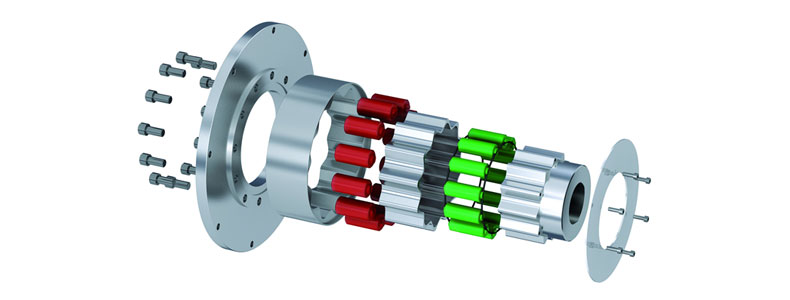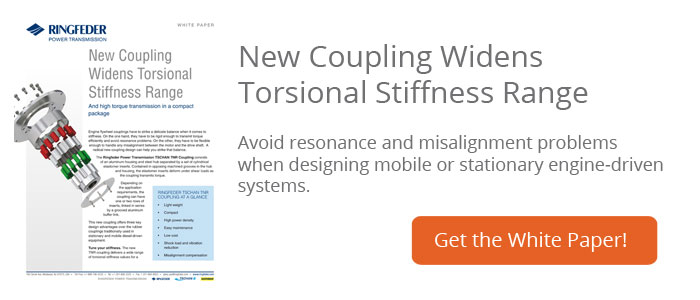New Coupling Design Offers Stiffness Adjustments

Motor shaft couplings have to strike a delicate balance when it comes to stiffness. On the one hand, they have to be rigid enough to transmit torque efficiently. On the other, they have to be flexible enough to handle any misalignment between the motor and the drive shaft. Our latest coupling design can help you strike that balance.
The RINGFEDER® TNR Coupling consists of an aluminum housing and steel hub separated by a set of cylindrical elastomer inserts. Contained in opposing machined grooves in the hub and housing, the elastomer inserts deform under shear loads as the coupling transmits torque.
Depending on the application requirements, the coupling can have one or two rows of inserts, linked in series by a grooved aluminum buffer layer. This patent-pending coupling offers a number of design advantages compared to traditional rubber couplings.
Tune Your Stiffness
The new coupling design gives you the ability to fine-tune torsional stiffness across a wide torque range by simply varying the material properties of the elastomer inserts. For example, our smallest TNR coupling can deliver dynamic torsional stiffness from 900 to 5,900 Nm/rad across a torque range of 160 to 510 Nm. That’s more than twice the stiffness range and three times the torque range of the closest comparable rubber couplings. The TNR’s ability to dial in a stiffness allows you to balance torque transmission efficiency and misalignment tolerance. Equally important, the precisely tuned dynamic stiffness can help you solve resonance and vibration problems to improve the overall performance of stationary or mobile diesel-driven powertrains.
Reduce Weight
TNR couplings typically weigh about 20% less than an equivalent rubber coupling. Keep in mind, however, that equivalent means same performance, not necessarily same size. Thanks to its wide torque and stiffness ranges, TNR couplings have a power density advantage that often allows a smaller, lighter model to replace a larger, heavier rubber coupling. This power density edge can make a big difference in mobile diesel applications, such as heavy equipment or trucks.
Save Money
Over its lifetime, a TNR coupling will typically cost 15 to 25% less than a comparable rubber coupling. This cost advantage includes a substantial savings on initial price. And it also includes a reduction in lifecycle costs—because replacing the elastomer inserts costs much less than replacing the rubber elements and attached steel hubs.


Comment